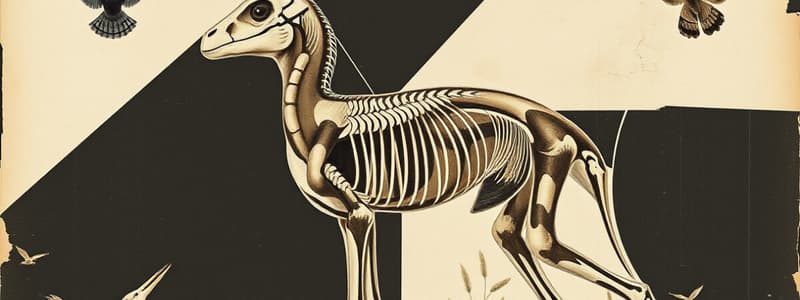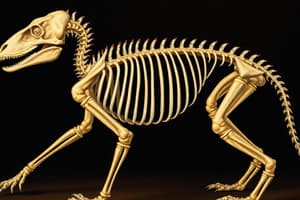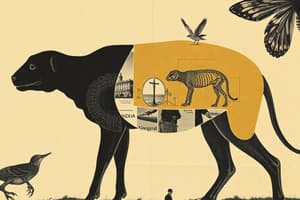Podcast
Questions and Answers
What distinguishes bilateral symmetry in animals?
What distinguishes bilateral symmetry in animals?
- Halves may resemble each other only at certain angles.
- Halves resemble each other when split in relation to the center. (correct)
- Halves are identical when split vertically but not horizontally.
- Halves do not resemble each other in any way.
Which term describes animals that lack a true body cavity?
Which term describes animals that lack a true body cavity?
- Pseudocoelomates
- Coelomates
- Acoelomates (correct)
- Eumetazoans
How are protostomes defined in embryological development?
How are protostomes defined in embryological development?
- The anus forms before the mouth.
- Both mouth and anus form simultaneously.
- The mouth develops first. (correct)
- They have a unique method of tissue arrangement.
What characteristic do all animals in the kingdom Animalia share?
What characteristic do all animals in the kingdom Animalia share?
Which of the following groups includes all vertebrates?
Which of the following groups includes all vertebrates?
What is the primary function of red blood cells?
What is the primary function of red blood cells?
What happens to blood if the left side of the heart fails to pump effectively?
What happens to blood if the left side of the heart fails to pump effectively?
Which blood type is considered a universal donor?
Which blood type is considered a universal donor?
Which structure acts as a drainage system for interstitial tissue fluid?
Which structure acts as a drainage system for interstitial tissue fluid?
What is the consequence of receiving the wrong blood type during a transfusion?
What is the consequence of receiving the wrong blood type during a transfusion?
Which phylum includes animals that have specialized stinging cells?
Which phylum includes animals that have specialized stinging cells?
What is a defining characteristic of segmented worms?
What is a defining characteristic of segmented worms?
Which of the following groups is primarily marine and characterized by soft bodies and protective shells?
Which of the following groups is primarily marine and characterized by soft bodies and protective shells?
Which type of worm has a flattened appearance and a single digestive tract opening?
Which type of worm has a flattened appearance and a single digestive tract opening?
What is a unique feature of the phylum Echinodermata?
What is a unique feature of the phylum Echinodermata?
What role do the testicles play in the male reproductive system?
What role do the testicles play in the male reproductive system?
Which structure is involved in fertilization within the female reproductive system?
Which structure is involved in fertilization within the female reproductive system?
What is the primary function of the circulatory system?
What is the primary function of the circulatory system?
Which part of the heart is responsible for pumping oxygenated blood to the body?
Which part of the heart is responsible for pumping oxygenated blood to the body?
What condition is characterized by a buildup of plaque in the coronary arteries?
What condition is characterized by a buildup of plaque in the coronary arteries?
What is a primary characteristic of echinoderms that differentiates them from many other marine invertebrates?
What is a primary characteristic of echinoderms that differentiates them from many other marine invertebrates?
What crucial role does water play in the movement of echinoderms?
What crucial role does water play in the movement of echinoderms?
How do arthropods maintain the structural integrity of their bodies?
How do arthropods maintain the structural integrity of their bodies?
What is the first step in the process of sexual reproduction in multicellular animals?
What is the first step in the process of sexual reproduction in multicellular animals?
Which part of the male reproductive system is considered external?
Which part of the male reproductive system is considered external?
Flashcards
Radial Symmetry
Radial Symmetry
A type of body symmetry where the animal can be divided into equal halves along any plane passing through the central axis. Examples include starfish and jellyfish.
Bilateral Symmetry
Bilateral Symmetry
A type of body symmetry where the animal can be divided into two symmetrical halves along a single plane. Most animals, including humans, exhibit bilateral symmetry.
Asymmetry
Asymmetry
A type of body symmetry where the animal does not have a symmetrical body plan. Examples include sponges and sea anemones.
Coelom
Coelom
Signup and view all the flashcards
Pseudocoelom
Pseudocoelom
Signup and view all the flashcards
Anterior
Anterior
Signup and view all the flashcards
Posterior
Posterior
Signup and view all the flashcards
Dorsal
Dorsal
Signup and view all the flashcards
Ventral
Ventral
Signup and view all the flashcards
Eumetazoans
Eumetazoans
Signup and view all the flashcards
Protostomes
Protostomes
Signup and view all the flashcards
Deuterostomes
Deuterostomes
Signup and view all the flashcards
Kingdom Animalia
Kingdom Animalia
Signup and view all the flashcards
Vertebrates
Vertebrates
Signup and view all the flashcards
Invertebrates
Invertebrates
Signup and view all the flashcards
Phylum Chordata
Phylum Chordata
Signup and view all the flashcards
Phylum Porifera
Phylum Porifera
Signup and view all the flashcards
Phylum Cnidaria
Phylum Cnidaria
Signup and view all the flashcards
Phylum Platyhelminthes
Phylum Platyhelminthes
Signup and view all the flashcards
Phylum Nematoda
Phylum Nematoda
Signup and view all the flashcards
Phylum Arthropoda
Phylum Arthropoda
Signup and view all the flashcards
Phylum Echinodermata
Phylum Echinodermata
Signup and view all the flashcards
Biological Clocks
Biological Clocks
Signup and view all the flashcards
Communication in Animals
Communication in Animals
Signup and view all the flashcards
Gametogenesis
Gametogenesis
Signup and view all the flashcards
Fertilization
Fertilization
Signup and view all the flashcards
Study Notes
Animal Body Plans
- Features and organization of animal body plans aid in classification and evolutionary studies.
- Body symmetry is a key differentiator:
- Radial symmetry allows for equal halves regardless of division.
- Bilateral symmetry results in symmetrical halves mirroring each other, seen in mammals, including humans.
- Asymmetry is rare, characterized by a lack of symmetry.
- Structural differentiation includes body cavities (coelom vs pseudocoelom) and the location of body structures: anterior (head), posterior (tail), dorsal (top), and ventral (bottom).
- Eumetazoans possess true tissues, while protostomes and deuterostomes are classified based on embryological development of mouth and anus.
Classification of Animals
- Kingdom Animalia comprises multicellular heterotrophs without cell walls.
- Animals are categorized into vertebrates (with backbones) and invertebrates (without backbones).
- Vertebrate classification includes five main types: fish, amphibians, reptiles, birds, mammals, all in Phylum Chordata.
- Over 90% of animal species are invertebrates, spread across more than 30 phyla and 1.3 million species.
Major Invertebrate Phyla
- Phylum Porifera: Sponges, immobile filter feeders.
- Phylum Cnidaria: Jellyfish, corals, and sea anemones with specialized stinging cells; over 10,000 species exist.
- Phylum Platyhelminthes: Flatworms, capable of regeneration; a tapeworm is a common example.
- Phylum Nematoda: Roundworms; many are parasitic, infecting hosts including humans.
- Phylum Arthropoda: Characterized by segmented bodies and an exoskeleton made of chitin; includes arachnids, crustaceans, and insects.
- Phylum Echinodermata: Marine animals with spiny skins, such as sea stars and sea cucumbers; exhibit pentaradial symmetry in adulthood.
Worm Types
- Types of worms include flatworms, roundworms, and segmented worms.
- Parasitic worms, known as helminths, affect hosts negatively.
- Hookworms and Ascaris are common parasitic infections in humans.
Mollusks Overview
- Invertebrates known for soft bodies, belonging to Phylum Mollusca.
- Common classes include:
- Gastropoda: Snails and slugs, some with shells.
- Bivalvia: Clams and oysters, filter feeders with two hinged shells.
- Cephalopoda: Squids and octopi, known for advanced eyes and ink production.
Echinoderms
- Divided into five classes: Asteroidea (sea stars), Echinoidea (sea urchins), Crinoidea (sea lilies), and more.
- Possess a calcium carbonate endoskeleton and a water vascular system aiding in movement and feeding.
- Can reproduce sexually and regenerate parts.
Arthropods
- Largest group of invertebrates with segmented bodies and an exoskeleton.
- Comprised of five major groups: Chelicerates, Myriapods, Crustaceans, Hexapoda (insects).
- Part of their success is attributed to their flexible exoskeleton and diverse adaptations.
Biological Clocks
- Internal biological clocks regulate daily rhythms in living organisms, known as circadian rhythms.
- Located in the hypothalamus for mammals; rely on environmental cues but maintain a set schedule independently.
Communication in Animals
- Effective communication relies on clear signals which can be visual, auditory, chemical, or electrical.
- Different signals serve specific purposes based on environmental context and species involved.
Sexual Reproduction in Animals
- Involves gametogenesis to produce sperm and ova.
- Fertilization leads to the formation of a zygote, which undergoes cleavage and germ layer development (ectoderm, mesoderm, endoderm).
Male Reproductive System
- Consists of external structures (penis, scrotum) and internal organs (testicles, epididymis, vas deferens).
- Testicles produce sperm and testosterone, regulated by temperature and reflex mechanisms.
Female Reproductive System
- Composed mainly of internal structures including ovaries, fallopian tubes, uterus, cervix, and vagina.
- Functions include gamete production, fertilization, and menstrual cycles; the uterine lining prepares for potential embryo implantation.
Circulatory System
- Comprises heart, blood, and vessels; consists of pulmonary (lungs) and systemic (body) circuits.
- Essential for nutrient transport, waste removal, immune response, and homeostasis.
Heart Anatomy
- Four chambers: right atrium, right ventricle, left atrium, left ventricle, separated by valves.
- Blood flow: from the body to the right atrium, to the lungs, back to the left atrium, and pumped to the body.
Heart Health
- Atherosclerosis causes plaque buildup, impacting blood flow and potentially leading to coronary heart disease.
- Poor heart function can result in angina or heart attacks, with chronic conditions leading to congestive heart failure.### Circulatory System
- Left heart failure causes blood to back up in the lungs, leading to difficulty breathing.
- Right heart failure results in blood pooling in the body, causing swelling in the lower extremities.
- The lymphatic system, an accessory to the cardiovascular system, is essential for its function.
- The lymphatic system consists of vessels and glands, acting as a drainage system for interstitial fluid to form lymph.
- Lymph contains white blood cells but no red blood cells or platelets.
- It plays roles in infection defense and absorbs fats and vitamins from the small intestine.
- Lymphatic vessels transport lymph with the help of breathing and muscle contractions.
- Lymph nodes filter out harmful microbes and are crucial for the immune system.
- Edema occurs when excess fluid is trapped in tissues and not returned to the bloodstream.
Blood Composition and Function
- Red blood cells (RBCs) comprise 40-45% of blood volume; they lack a nucleus and primarily function to carry oxygen and carbon dioxide.
- Hemoglobin, a protein in RBCs, binds oxygen due to its iron content.
- RBCs are produced in red bone marrow from stem cells called hemocytoblasts, maturing from protoerythroblasts.
- RBCs circulate for about 120 days before being destroyed by the liver and spleen.
- Anemia describes a lower than normal number of red blood cells.
Blood Groups and Transfusions
- The ABO blood group system classifies blood based on A and B antigens present on RBCs.
- Blood types: A (with A antigen), B (with B antigen), AB (both A and B antigens), and O (no antigens).
- Type AB individuals can receive any blood type (universal recipient), while type O people can donate to anyone (universal donor).
- Incorrect blood transfusions cause agglutination, leading to harmful clumping of RBCs.
Blood Vessel Structure and Function
- Blood travels from the heart through arteries, arterioles, capillaries, venules, and back to the heart via veins.
- Arteries have elastic walls; arterioles control blood flow into tissues through muscle contraction.
- Capillaries allow gas and nutrient exchange; they are the smallest blood vessels.
- Deoxygenated blood returns through venules and veins, which have thinner walls than arteries, and contain one-way valves to prevent backflow.
- Skeletal muscle contraction aids venous return to the heart.
Heart and Pulmonary Circulation
- Deoxygenated blood from the right ventricle goes to the lungs via the pulmonary artery.
- Lungs oxygenate the blood, which returns to the left atrium through pulmonary veins.
- The left ventricle pumps freshly oxygenated blood into the aorta for systemic distribution.
Aorta and Major Veins
- Aorta is the largest blood vessel, with branches supplying major body areas.
- Thoracic aorta branches include the ascending aorta, aortic arch, and descending aorta.
- The abdominal aorta gives rise to the celiac trunk (supplies digestive organs) and common iliac arteries (supply legs).
- The superior vena cava returns blood from the upper body, while the inferior vena cava returns blood from the lower body.
Urinary System
- Composed of kidneys, ureters, bladder, and urethra; it creates, stores, and transports urine.
- The system removes toxins and waste from the body.
- Liver plays a critical detoxification role.
- Conditions affecting the urinary system include UTIs, incontinence, and kidney stones.
Digestive System
- The mouth initiates digestion, mixing food with saliva.
- Saliva contains enzymes like amylase, facilitating taste and digestion.
- Salivary insufficiency can lead to infections like thrush and ulcers.
Endocrine System
- Composed of hormones-secreting glands; hormones regulate bodily functions via a lock-and-key mechanism targeting specific cells.
- Examples include insulin (blood sugar control), testosterone, and estrogen (sexual development).
- The hypothalamic-pituitary axis regulates hormone levels.
Hormonal Conditions
- Growth hormone regulates physical growth; imbalances lead to dwarfism or gigantism.
- FSH and LH are crucial for reproduction; deficiencies can cause infertility.
- Diabetes insipidus results from insufficient ADH, causing excessive urination.
Thyroid Function
- The thyroid gland regulates metabolism with hormones requiring iodine; deficiency can cause goiter.
- Hypothyroidism slows metabolism; hyperthyroidism, such as in Graves' disease, can lead to symptoms like exophthalmos.
Diabetes Mellitus
- Characterized by insufficient insulin production or resistance, resulting in high blood sugar levels.
- Classic symptoms include increased urination, thirst, and hunger.
- Types: Type 1 (insulin absence), Type 2 (insulin resistance), and gestational diabetes during pregnancy.
Skeletal Muscle Anatomy and Disorders
- Skeletal muscles allow voluntary movement and connect to bones via tendons.
- Muscle fibers contain myofibrils made of actin and myosin, resulting in striated muscle appearance.
- Functions include movement, support, and thermoregulation.
- Conditions affecting skeletal muscles include cramps, muscular dystrophy, and carpal tunnel syndrome.
Connective Tissue
- Connective tissue supports and protects body structures, including fibrous connective tissue composed of collagen fibers.
- Types include ligaments (connect bones), tendons (connect muscles), and fasciae (connect muscles).
- The Achilles tendon is the strongest tendon, while tendonitis refers to tendon inflammation.
Vision Anatomy
- Light enters the eye via the cornea and passes through the pupil, controlled by the iris.
- The lens focuses light onto the retina, aided by ciliary muscles that adjust its shape.
- Photoreceptors in the retina include rods (for low light) and cones (for color and sharp vision).
- Rods contain rhodopsin and perceive shades of gray, with a concentration towards the retina's periphery; cones facilitate color vision in bright conditions.### Photoreceptors in the Retina
- Cone cells are cone-shaped photoreceptors in the retina, distinct from rod-shaped ones.
- Each type of cone contains unique photopigments responsive to specific light wavelengths: short (blue), medium (green), and long (red).
- Approximately 6-7 million cones are present in a single retina, with the highest density located in the fovea centralis.
- The fovea centralis, a small depression in the macula, contains only cone cells, responsible for the clearest color vision.
Structure and Function of the Ear
- The external ear collects sound vibrations transforming them into electrical signals for the brain.
- Key components of the external ear include:
- Pinna: The visible outer ear structure.
- Ear Canal: Also known as the auditory canal or external acoustic meatus.
- The ear's unique shape aids in amplifying sound and enhancing detail about vibrations.
- Vibrations in air cause particles to move, and these disturbances ultimately reach the tympanic membrane (eardrum).
- Upon receiving vibrations, the eardrum vibrates and sends these vibrations through the middle ear via tiny bones.
- Vibrations enter the inner ear and move the fluid within the cochlea, a spiral-shaped structure.
- The cochlea contains microscopic hairs that react to fluid movement, stimulating nerves and generating electrical signals sent to the brain for sound interpretation.
Studying That Suits You
Use AI to generate personalized quizzes and flashcards to suit your learning preferences.



